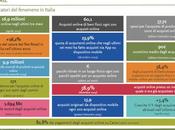In questo modo cerchiamo di avvicinare questi due mondi che spesso, per forza di cose e per via di competenze ovviamente differenti, non parlano la stessa lingua!
Questa infografica mostra, in concreto, quanto lavoro c'è dietro allo sviluppo di un sito web.
Ecco quindi i 26 "comandamenti" da non dimenticare quando si crea un sito web.
![26 Punti Fondamentali nello Sviluppo di un Sito Web [INFOGRAFICA] 26 Punti Fondamentali nello Sviluppo di un Sito Web [INFOGRAFICA]](http://m2.paperblog.com/i/176/1768490/26-punti-fondamentali-nello-sviluppo-di-un-si-L-XX_Jue.jpeg)
1) Dominio - Scegliere un nome facile da ricordare!
2) Hosting - Scegliere uno spazio web affidabile e con lo spazio adatto alle esigenze.
3) Tecnologia - Valutare la tecnologia da utilizzare: Html5, Css3, Php, JQuery, Javascript, etc.4) Scopo del sito - Decidere come orientare il sito: business, e-commerce, aziendale, etc.5) Layout e Colori - L'aspetto grafico dice molto di un sito, uno stile semplice e pulito è sempre una scelta efficace.
6) Mappa sito - Inserire una site map chiara, perdersi su un sito non è mai piacevole.
7) Contenuti - Il sito web deve fornire contenuti di qualità ed utili, oltre a contenere le parole chiave per essere indicizzati sui motori di ricerca.8) Target - E' importante sapere a quali utenti è destinato il sito per inserire contenuti che possano essere interessanti per loro.9) Pubblicità - Non inserire troppa pubblicità nel sito web, gli utenti non gradiscono gli alberi di natale quando cercano informazioni navigando.10) Pop up - Sono noiosi, rallentano il sito e disturbano la navigazione: meglio evitarli.
11) Design efficace - Semplici e professionali: ecco i siti che funzionano.12) Pulsanti - Curare questi elementi in modo da invogliare la navigazione tra le pagine o le azioni che vogliamo far fare ai nostri utenti (download, compra, iscriviti, etc.)13) Sfondo - Decidere tra uno sfondo pulito, colorato o con un tema.
14) Immagini - Sceglierle con cura, perchè (scusate il gioco di parole) fanno parte dell'immagine generale che da il sito in se'.
15) Facilità di navigazione - Permettere agli utenti in pochi click di arrivare alle informazioni che cercano.
16) Originalità - Sviluppare un sito nell'ottica di dargli un valore aggiunto rispetto agli altri.
17) Aggiornamenti - Un sito con contenuti sempre freschi e aggiornati garantisce un ritorno di utenti nel tempo.18) Ottimizzazione - Parole chiave, testi, immagini e tutto ciò che si può ottimizzare per migliorare l'indicizzazione sui motori di ricerca.19) Browser - Testare il sito sui tutti i browser più usati (Chrome, Firefox, Safari, Explorer)
20) Risoluzione - Generalmente i siti andrebbero sviluppati a 980px di larghezza, ma con l'avvento del "responsive web design", lo standard si è spostato sui 1230 px.
21) Social Media - Integrare i social sul sito per facilitarne la condivisione dei contenuti in rete.
22) Font - Scegliere un font leggibile in modo da rendere la lettura facile per gli utenti.23) Registrazione - Prevedere una registrazione per interagire e fidelizzare gli utenti (newsletter, contenuti speciali, download di file, etc.)24) Tracking e Analisi dati traffico - Monitorare il traffico del sito per rendere più efficace il lavoro di ottimizzazione.
25) Sicurezza - Se il sito raccoglie dati sensibili (nomi, indirizzi, telefono, carte di credito) utilizzare le misure necessarie per proteggere la privacy dei propri utenti.26) Footer - Non è sicuramente l'elemento principale di un sito, ma un footer curato e in linea con il sito, colpirà gli utenti.
Ne avete altri da aggiungere? Scriveteceli a [email protected]!
Aggiungici
![26 Punti Fondamentali nello Sviluppo di un Sito Web [INFOGRAFICA] Skype Me™!](http://m2.paperblog.com/i/176/1768490/26-punti-fondamentali-nello-sviluppo-di-un-si-L-nZsNh0.jpeg)
_______________________________________________________________________________
The network is always a pool of news, insights and interesting ideas. And just surfing the net, we found this infographic (made by Pixaal.com) that contains 26 important points to focus befor developing a website. We want to share it with both the insiders like us, and with those who are on the other side of the table, with which every day we interface to enhance, promote and increase their business through the innovative tools that Internet provides.
In this way we try to bring close these two worlds that often, because of the different skills of course, do not speak the same language!
This infographic shows, in concrete terms, how much work there is behind the development of a website.
So here are the 26 "commandments" to remember when developing a website.
1) Domain name - Choose a name easy to remember!
2) Hosting - Choosing a reliable web space and that suits your needs.
3) Technology - Deciding the technology to be used: HTML5, CSS3, PHP, JQuery, Javascript, etc..
4) Purpose of the site - Decide how to orient the site: business, e-commerce, corporate, etc..
5) Layout and Colors - The look and feel says a lot about a site, simple and clean is always a good choice.
6) Site Map - Insert a clear site map, get lost on a site is never pleasant.
7) Content - The website must provide quality and useful content, in addition to containing the keywords to be indexed on search engines.
8) Target - It's important to know users target of the site to post content that may be of interest.
9) Advertising - Do not put too much advertising on the website, users do not like Christmas trees when browsing seeking information.
10) Pop up - Thery are boring, slow down your site and disrupt navigation: better avoided them.
11) Design effective - Simple and professional: these are the sites that work.
12) Buttons - Treating these elements to entice the navigation between the pages or the actions that we want our users to make (download, buy, subscribe, etc.).
13) Background - Deciding between a clean background, colored or with a theme.
14) Pictures - Choosing them carefully, because are part of the overall picture from the site itself.
15) Easy Navigation - Allow users in a few clicks to get to informations they seek.
16) Unique - Develop a website in order to give added value compared to others.
17) Updates - A site with fresh and updated contents always guarantees a return of users over time.
18) Optimization - Keywords, text, images and all that can be optimized to improve in indexing on search engines.
19) Browser - Test your site on all browsers (Chrome, Firefox, Safari, Explorer)
20) Resolution - In general the sites should be developed to 980px width, but with the advent of "responsive web design", the standard has shifted to 1230 px.
21) Social Media - Integrating social on the website to facilitate sharing content on the network.
22) Font - Choose a clear font in order to make the reading easier for users.
23) Registration - Provide a registration to interact and retain users (newsletters, special content, file downloads, etc.).
24) Tracking and Analytics - Monitor site traffic to make more effective optimization work.
25) Provide Security - If your site collects personal data (names, addresses, phone, credit cards) use the necessary measures to protect the privacy of users.
26) Footer - It is definitely not the main element of a site, but a nice and footer in line with site design, users will hit.
Do you have more to add? Write us to [email protected]!
Add us
![26 Punti Fondamentali nello Sviluppo di un Sito Web [INFOGRAFICA] Skype Me™!](http://m2.paperblog.com/i/176/1768490/26-punti-fondamentali-nello-sviluppo-di-un-si-L-RcHbwN.jpeg)






